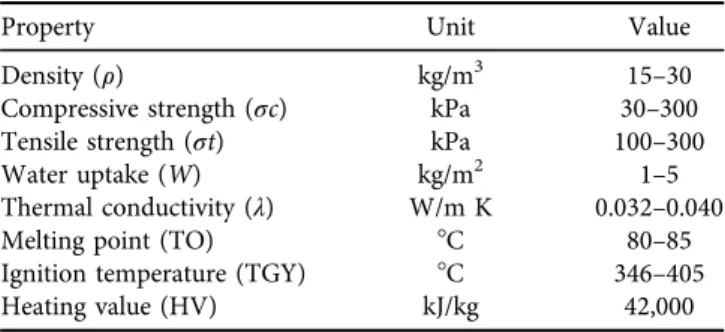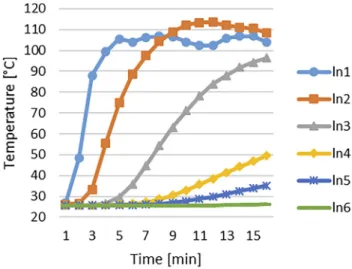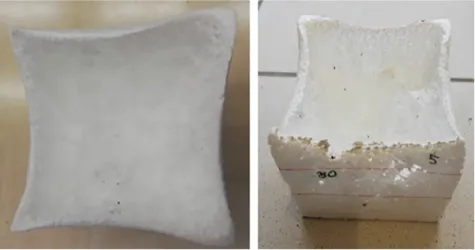used in buildings
Fl ora Hajdu
1p, Gabriella L aszlo
2and Rajmund Kuti
11Department of Mechatronics and Machine Design, Faculty of Mechanical Engineering, Informatics and Electrical Engineering, Szecsenyi Istvan University, Egyetem ter 1, H-9026 Gy}or, Hungary
2Doctoral School of Multidisciplinary Engineering Sciences, Szechenyi Istvan University, Egyetem ter 1, H-9026 Gy}or, Hungary
Received: December 31, 2020 • Revised manuscript received: April 7, 2021 • Accepted: April 10, 2021 Published online: May 29, 2021
ABSTRACT
In recent years, in order to increase the energy efficiency of older buildings in Hungary, several tenders have supported the modernization of the thermal insulation. Various thermal insulation materials have been installed on walls, on slab and on floor. Unfortunately there are cases where thermal insulation materials are not installed in accordance with the construction permit or the manufacturer’s in- structions, which poses a serious danger in case of afire. During the research the effects of heat on the behavior of Expanded PolyStyrene, a thermal insulation material often used in Hungary is examined.
Laboratory tests and computer simulations were carried out, which are presented in detail in this paper.
The aim of the research is to contribute to increase thefire safety of buildings.
KEYWORDS
insulating materials, indoor fire, heat measurement, simulation
1. INTRODUCTION
Fires occur quite often in various buildings in Hungary, therefore fire protection of building materials is an important, current issue [1]. Modernization of existing buildings will become topical after a certain period of time, during which thefire protection aspects must also be met. Knowledge offire protection properties of the installed materials and appli- cation of the appropriate installation technology is extremely important infire protection practice. One of the significant steps in the modernization of buildings is to increase their thermal insulation, which in case of old buildings is realized posteriorly. In the last two decades the government has also supported energy modernization, which has resulted in the thermal insulation of a large number of old buildings. One of the frequently used thermal insulation materials was Expanded PolyStyrene (EPS), which must be installed according to a separate standard [2]. Unfortunately, in practice, the installation regulations were not always followed by the contractors and it was only revealed duringfires [3,4]. It turned out for example that EPS was used not only for external thermal insulation, but also for internal thermal insulation placed over a built-in suspended ceiling or used as a sound insulation in a nightclub behind a similar perforated plate. EPS should not be used indoors because the direct combustion of it produces large amounts of toxic combustion products, like CO (carbon-monoxide), CO2 (carbon-dioxide), HBr (hydrogen-bromide), HCl (hydrogen-chloride), SO2(sulfur-dioxide), which reduces the chances of survival of people in thefire-affected room [5]. The aim of the research is to investigate the changes in the EPS material due to direct heat in laboratory environment. Using results of the measure- ment the development of computer simulation has also been initialized in order to help to understand the phenomena more accurately and also contribute to the planning of future research tasks.
Pollack Periodica • An International Journal for Engineering and Information Sciences
16 (2021) 3, 108–113
DOI:
10.1556/606.2021.00377
© 2021 The Author(s)
ORIGINAL RESEARCH PAPER
pCorresponding author.
E-mail:hajdfl@sze.hu
2. LABORATORY MEASUREMENTS
In practice it was observed that deformations had occurred in the EPS insulations due to radiant heat. The standard tests mostly examine the ignitability and fire properties of ma- terials [6], therefore a different laboratory experiment was performed to examine the temperature increase and the mass loss of EPS. In the scientific literature some examples of examining the behavior of EPS due to radiant heat can be found. However, different measurement devices and methods were used and different phenomena were investi- gated in these papers (e.g., the effect of solar radiation, the effect of sample width, etc.) [7–10]. During the experiment presented in this paper the temperature of the heat source can be adjusted precisely and the heat radiation reaching the surface of the EPS sample can be measured accurately, therefore the internal temperature change of EPS can be effectively detected.
Before starting the laboratory measurements, the prop- erties connected to fire protection of the selected EPS were studied. During production of EPS thermal insulation ma- terial pentane (C5H12) is added to polymerized styrene as a first step. During the expansion, water vapor is introduced into the polystyrene granules and as a result the particles of the raw material soften. As the temperature increases, the pentane propellant swells the polystyrene beads 20-50-fold while forming tiny, closed cells within the polystyrene beads.
The expanded polystyrene cannot be used immediately; a blocking process is required first. The surface of the beads hardens due to cooling, the propellant contracts and air diffuses into the formed cells. During rest moisture added during steaming evaporates from the beads. The pre-foamed beads are then re-steamed in a closed form, during which the beads are pressed together to form a homogeneous block without binder. After resting, these blocks are cut to size [11].
EPS is a thermoplastic material, therefore at higher temperatures (aboveþ80 8C) its load capacity and dimen- sional stability deteriorate and it deforms under the influ- ence of heat. Therefore is not recommended for use in places permanently exposed to temperatures above þ70 8C. EPS used for thermal insulation is treated with aflame retardant, therefore the material does not burn on its own after the ignition source or directfire has been extinguished. Thermal properties EPS are summarized inTable 1.
Measurements were performed with an adjustable tem- perature heat source with heat sensors placed in front of it and in the test specimen and a six-channel data logger. The measurement results were recorded by a computer con- nected to the device. The measuring equipment and the sketch of the measurement are shown inFig. 1.
Samples with a uniform width of 10 3 10 cm and a length corresponding to the material thickness were pre- pared. In each sample thermocouples were placed 3 cm apart at a depth of 5 cm from the side, and then the sample was fixed to holder stand 5 cm in front of the heat source.
During the measurements, the heat source was set to a temperature of 5008C. The temperature sensor in front of the sample (fixed on the sample holder stand) measured a temperature of 100 8C because of the air gap between the
Table 1.Thermal properties of EPS (by Authors bases on [12])
Property Unit Value
Density (r) kg/m3 15–30
Compressive strength (σc) kPa 30–300
Tensile strength (σt) kPa 100–300
Water uptake (W) kg/m2 1–5
Thermal conductivity (λ) W/m K 0.032–0.040
Melting point (TO) 8C 80–85
Ignition temperature (TGY) 8C 346–405
Heating value (HV) kJ/kg 42,000
Fig. 1.Measurement device (up) and measurement sketch (down)
heat source and the device. At the beginning of the mea- surement, the thermal insulation sheet was removed and then the sample was exposed to radiant heat at 1008C for a period of 10 min and in the case of a 20 cm wide sample for 16 min.
During measurements it was experienced that after approximately 3 and 6 min the temperature was above 120–
1408C at the first temperature sensor placed into the sample, which suggests that in the EPS samples exothermic processes start after a short period of time at temperature 1008C. The measurement results are shown inFigs 2–4.
Analyzing the results, it can be stated that after 3–4 min, the temperature measured by the first sensor in both the 12 and 15 cm samples exceeded the temperature of 1008C, and then further increased to approximately 1208C. In case of the second sensor it took 6–7 min to reach a temperature of 1008C. By the end of the measurement time, the tempera- ture measured at the second sensor approached 1208C with no further increase. However the temperature measured by the first sensor has started to decrease. No flame combustion occurred, but mild smoke was observed in all experiments.
In case of the 20 cm thick sample it can be seen that after 3–4 min the temperature measured by the first sensor reached 1008C, then increased further to approximately 110 8C. The temperature measured by the second sensor excee- ded the temperature measured by the first sensor after 8 min and further increased to 1158C, then decreased continuously until the end of the measurement.
The weight of each sample was measured before and after the measurement and the results are shown in the followingTable 2.
Analyzing the results it can be concluded that the exothermic processes in the samples were accompanied by weight loss and deformation, which can be clearly seen in Fig. 5. Smoke was also experienced during the measure- ments. Combustion with a flame did not occur, only oxidation happened.
3. COMPUTER SIMULATION
Finite element simulations can be effectively used to examine fire behavior of building elements and materials [13]. In this research Fire Dynamic Simulator (FDS) was used [14], which was already used effectively to simulate indoorfires [15–18]. The simulation environment was set up based on the measurement described in Section 2. The temperature rise in the measurement points and the material loss were examined. The simulation environment was 1203 2203130 mm open space. The temperature at surface y50 was 5008C. The mesh size was 53 535 mm. The simu- lation time was 600 s according to the measurement time.
The simulation model is shown isFig. 6.
Fig. 2.Measurement results of the EPS sample with 12 cm width
Table 2.Mass change of samples during the experiments Size (mm) Mass (g) Mass loss (g) Mass loss %
10031003120 18.22 0.14 0.774
10031003150 24.98 0.26 1.051
10031003200 30.05 0.24 0.805
Fig. 3.Measurement results of the EPS sample with 15 cm width
Fig. 4.Measurement results of the EPS sample with 20 cm width
Temperature sensors were placed according to the measurement set-up shown inFig. 1. The simulation results are shown inFig. 7.
It can be seen that in case of the first sensor (which is placed at the supporting frame in case of the measure- ment) the temperature rises to 101.248C similarly to the measurement. The maximum temperature is reached after 33.6 s. In case of the second sensor (which is the first sensor placed inside the sample) the temperature rises till 85.38C after 228 s. Therefore the maximum temperature is
reached approximately 3 min after the surface of the sample reached 1008C. The maximum temperature in case of the third sensor (second placed inside the sample) is 71.34 s and is reached after 492 s. Therefore the maximum temperature was reached after 7.6 min. The time to reach the maximum temperature is similar to the measurement.
The maximum temperature is smaller, because the mate- rial was burned and the air temperature decreased because of the open space. Also there remained less material to burn and to increase the temperature further. In case of the other sensors there was no temperature change. It is because the material was not burned therefore the tem- perature of the combustion gases could not be measured.
The mass loss was also estimated, which was 58%. It is much more than in case of the measurement. Therefore the simulation model should be improved in the future to capture the exotherm phenomena inside the EPS material more accurately.
Fig. 5.Deformation of the EPS sample due heat
Fig. 6.Simulation model
Fig. 7.Simulation results
3.1. Simulation of a room with insulating material
The results presented above can also be used in the devel- opment of simulations of indoor fires. To begin with the research two types of preliminary simulation models were already created, which are shown inFig. 8.
The wall temperature was measured, the simulation time was 60 s. The room and the fire model were based on [19].
In thefirst case the insulating material was specified as wall.
In this case the heat load and the temperature of the walls and the room can be examined (Fig. 9).
In the second case the insulating material was modeled as a separate object. The advantage of this model, those combustion properties can also be specified.
With this model the combustion of the insulating mate- rial, fire spread and fire damage can be examined (Fig. 10).
These simulations were run on a simple laptop. Using a rough mesh the calculation time was 32 min in the first case and 60 min in the second case. It is an ongoing research;
therefore it is yet to decide which simulation model will be used to model indoor fires.
4. CONCLUSION
Continuous testing of insulating materials is very impor- tant to increase fire safety of buildings. Research results in the topic also contribute to the further development of products and materials. The performed experiments revealed that exothermic processes start in the examined EPS samples under the influence of heat even at 100 8C, which is accompanied by smoke formation. Knowing the properties of the insulating material, it can be concluded that smoke contains substances, which are harmful to hu- man health. Therefore the use of EPS materials is not recommended indoors for either heat or sound insulation.
The examined samples were the thickest available in order to observe the phenomena more accurately. At the same time a thinner sample loses its weight much sooner (pen- etrates) due to direct heat load as a result of which the building structure or equipment protected by it receives the heat load, which may even lead to fire. In the course of the presented research work it can be concluded that labora- tory experiments are essential to create simulations that help to improve insulating materials. Experimental results help to fine-tune simulations therefore more accurate simulations can be performed in the future. In addition to the presented results the tasks of further research were also defined.
Fig. 8.Simulation of indoorfire with insulating material (up:
insulating material defined as wall, down: insulating material defined as object)
Fig. 9.Temperature rise in case of thefirst simulation model
REFERENCES
[1] D. Bozsaky,“Recent studies on thermodynamic processes in nano- ceramic thermal insulation coatings”, Pollack Period., vol. 14, no. 1, pp. 107–116, 2019.
[2]MSZ 7573: 2015, Thermal insulation products for buildings, Factory made expanded polystyrene (EPS) products (in Hungarian), Magyar Szabvany€ugyi Test€ulet, 2015.
[3] L. G. Takacs,“Fire Cases in Low Energy Buildings”(in Hungarian), Vedelem Online, T}uz-es Katasztrofavedelmi Szakk€onyvtar, 2013.
[Online]. Available:http://www.vedelem.hu/letoltes/document//9- alacsony-energiaigenyu-epuletek-tuzeseti-tapasztalatai.pdf.
Accessed: Dec. 1, 2020.
[4] M. Lestyan,“Fire protection issues of thermal insulation systems” (in Hungarian), Vedelem Online, T}uz-es Katasztrofavedelmi Szakk€onyvtar, 2015. [Online]. Available:http://vedelem.hu/files/
UserFiles/File/konf2012/lakitelek/Lestyan_Hoszigetelo_rendszerek_
tuzvedelmi_kerdesei.pdf. Accessed: Dec. 10, 2020.
[5] R. Kuti and G. Zolyomi,“Hazards from smoke duringfires”(in Hungarian), Vedelem Tudomany: Katasztrofavedelmi Online Tudomanyos Folyoirat, vol. 3, no. 2.III/2, pp. 67–76, 2019. [On- line]. Available: http://www.vedelemtudomany.hu/articles/05- kuti-zolyomi.pdf. Accessed: Dec. 10, 2020.
[6]ISO 11925-2:2020, Reaction tofire tests, Ignitability of products subjected to direct impingement offlame, Part 2: Single-flame source test, International Organization for Standardization, 2020.
[7] G. B. Baker, Performance of expanded polystyrene insulated panel exposed to radiant heat, Fire Engineering, Research report, no. 722, University of Canterbury, Christchurch, New Zealand, 2002.
[8] P. Krause and A. Nowoswiat,“Experimental studies involving the impact of solar radiation on the properties of expanded graphite polystyrene”,Energies, vol. 13, no. 1, pp. 1–17, 2019.
[9] R. Coquard, D. Baillis, and D. Quenard,“Heat transfer in low- density EPS foams,” in 12th International Meeting on Heat Transfer, Tanger, Morocco, Nov. 15–17, 2005, 2005, pp. 291–294.
[10] A. Blazejczyk, C. Jastrzebski, and M. Wierzbicki, “Change in conductive-radiative heat transfer mechanism forced by graphite microfillerin expanded polystyrene thermal insulation - Experi- mental and simulated investigations,” Mater., vol. 13. no. 11, Paper no. 2626, pp. 1–26, 2020.
[11] B. Pukanszky and J. Moczo,Plastics (in Hungarian). Budapest:
Typotex Kiado, 2012.
[12] M. Lestyan, “Wherever we try to test, polystyrene foam is combustible”(in Hungarian),Vedelem Katasztrofa-es T}uzvedelmi Szemle, vol. 18, no. 5, pp. 40–42, 2011. [Online]. Available:http://
vedelem.hu/letoltes/ujsag/v201105.pdf. Accessed: Dec. 10, 2020.
[13] B. Sajadian and H. Ashrafi,“Fire performance of concrete sandwich panel under axial load”,Pollack Period., vol. 15, no. 1, pp. 45–52, 2020.
[14] K. McGrattan, S. Hostikka, J. Floyd, R. McDermott, and M.
Vanella,Fire dynamics simulator, User’s guide. [Online]. Available:
https://github.com/firemodels/fds/releases/download/FDS6.7.5/
FDS_User_Guide.pdf. Accessed: Dec. 29, 2020.
[15] X. Cheng, Y. Zhou, H. Yang, and K. Y. Li,“Numerical study on temperature distribution of structural components exposed to travellingfire,”Proced. Eng., vol. 71, pp. 166–172, 2014.
[16] D. Zigar, D. Pesic, I. Anghel, and N. Misic,“Simulation offire radiative heatflux through compartment openings using FDS,”in PozarnıOchrana, Ostrava, Czech Republic, Sep. 9–10, 2015, 2015, pp. 380–383.
[17] A. C. Y. Yuen, G. H. Yeoh, R. Alexander, and M. Cook,“Fire scene reconstruction of a furnished compartment room in a housefire,” Case Stud. Fire Saf.,vol. 1, pp. 29–35, 2014.
[18] C.-S. Ahn and J.-Y. Kim,“A study for afire spread mechanism of residential buildings with numerical modeling,”WIT Trans. Built Environ., vol. 117, pp. 185–196, 2011.
[19]FDS tutorial. [Online]. Available: https://fdstutorial.com/your- first-fds-simulation/. Accessed: Oct. 10, 2020.
Open Access. This is an open-access article distributed under the terms of the Creative Commons Attribution 4.0 International License (https://creativecommons.org/
licenses/by/4.0/), which permits unrestricted use, distribution, and reproduction in any medium, provided the original author and source are credited, a link to the CC License is provided, and changes–if any–are indicated. (SID_1)
Fig. 10.Temperature rise in case of the second simulation model




